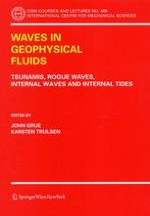2006 | OriginalPaper | Buchkapitel
Freak Waves Phenomenon: Physical Mechanisms and Modelling
verfasst von : Christian Kharif, Efim Pelinovsky
Erschienen in: Waves in Geophysical Fluids
Verlag: Springer Vienna
Aktivieren Sie unsere intelligente Suche, um passende Fachinhalte oder Patente zu finden.
Wählen Sie Textabschnitte aus um mit Künstlicher Intelligenz passenden Patente zu finden. powered by
Markieren Sie Textabschnitte, um KI-gestützt weitere passende Inhalte zu finden. powered by
The main physical mechanisms responsible for the formation of huge waves known as freak waves are described and analyzed. Data of observations in the marine environment as well as laboratory experiments are briefly discussed. They demonstrate that freak waves may appear in deep and shallow waters. The mathematical definition of these huge waves is based on statistical parameters, namely the significant height. As linear models of freak waves the following mechanisms are considered: Wave-current interaction and dispersion enhancement of transient wave packets. When the nonlinearity of the water waves is introduced, these mechanisms remain valid but should be modified and new mechanisms such as modulational instability and soliton-collisions become good candidates to explain the freak wave occurrence. Specific numerical simulations were performed within the framework of classical nonlinear evolution equations: The Nonlinear Schrödinger equation, the Davey-Stewartson system, the Korteweg-de Vries equation, the Kadomtsev-Petviashvili equation, the Zakharov equation and the fully nonlinear potential equations. Their results show the main features of the physical mechanisms of freak wave phenomenon.
